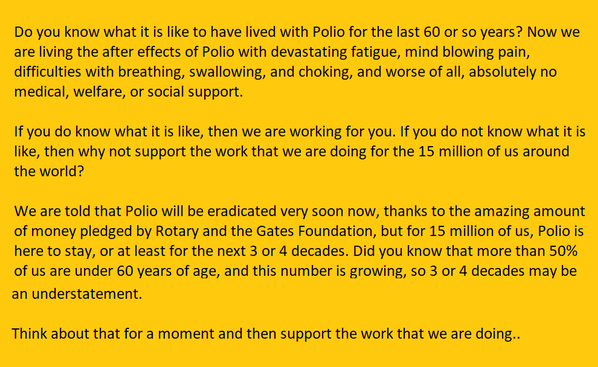Post-Polio Syndrome: Difference between revisions
No edit summary |
No edit summary |
||
| Line 8: | Line 8: | ||
Non-motor symptoms of PPS have considerable quality of life implications and are notoriously challenging to manage, and yet very few Medical Professionals have even a slight knowledge of Polio, and even less of PPS. | Non-motor symptoms of PPS have considerable quality of life implications and are notoriously challenging to manage, and yet very few Medical Professionals have even a slight knowledge of Polio, and even less of PPS. | ||
[[File:Pps1.png|thumb|598x598px]] | [[File:Pps1.png|thumb|598x598px]] | ||
Every person who was caught by the Polio virus had damage to 98% of their motor neurons, with these motor neurons receiving either a minimum of 58% damage, or total destruction. | |||
Many Polio victims were never diagnosed as their symptoms could have been only 'flu like' and would have gone unnoticed | |||
Even those of us who had 58% of our motor neurons damaged would never be paralyzed. | |||
Our parents were told that our recovery was stable and once our muscle strength and physical abilities returned, they will remain stable for the rest of our lives, in fact we developed unexpected and disabling symptoms about 35 years after the acute polio virus attack. | |||
Post-Polio Syndrome or Post-Polio Sequelae symptoms: | |||
* 91% - Fatigue | |||
* 82% - Muscle Weaknes | |||
* 76% - Muscle Pain | |||
* 75% - Joint Pain | |||
* 60% - Cold Intolerance | |||
* 50% - Sleep Disorders | |||
* 15% - Difficulty Swallowing | |||
* 5% - Breathing Issues | |||
Revision as of 16:20, 24 November 2019
Living with Post-Polio Syndrome[edit | edit source]
When we left hospital after contracting Polio, ( know as Infantile Paralysis many years ago ), regardless of the disabilities bequeathed us by the Polio Virus, the last thing told us by our attending Physician, now burnt into our memory was "You must use it, or lose it"
How wrong was this statement, and since that fateful day we have been unwittingly destroying, or further damaging, already seriously damaged motor neurons, to such a degree that almost 70% of Polio Survivors are now experiencing one of the most devastating debilitating neurodegenerative condition in the world.
Non-motor symptoms of PPS have considerable quality of life implications and are notoriously challenging to manage, and yet very few Medical Professionals have even a slight knowledge of Polio, and even less of PPS.
Every person who was caught by the Polio virus had damage to 98% of their motor neurons, with these motor neurons receiving either a minimum of 58% damage, or total destruction.
Many Polio victims were never diagnosed as their symptoms could have been only 'flu like' and would have gone unnoticed
Even those of us who had 58% of our motor neurons damaged would never be paralyzed.
Our parents were told that our recovery was stable and once our muscle strength and physical abilities returned, they will remain stable for the rest of our lives, in fact we developed unexpected and disabling symptoms about 35 years after the acute polio virus attack.
Post-Polio Syndrome or Post-Polio Sequelae symptoms:
- 91% - Fatigue
- 82% - Muscle Weaknes
- 76% - Muscle Pain
- 75% - Joint Pain
- 60% - Cold Intolerance
- 50% - Sleep Disorders
- 15% - Difficulty Swallowing
- 5% - Breathing Issues







